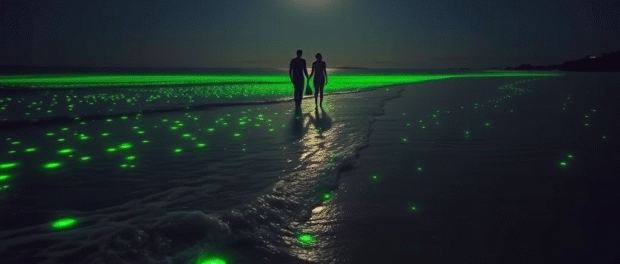Surprise! Trees Do NOT Make Most of Earth’s Oxygen. Here’s What Does:

A Personal Encounter with Nature’s Divine Glow Signals & Microscopic Miracles
Six years ago, on a moonlit night at the famous Flora-Bama restaurant/bar, I experienced what I initially thought was just a romantic sign from above. Walking along the shoreline with an attorney on our first date, we witnessed thousands of bioluminescent plankton creating a magical display of neon green light where the waves crashed around us. At the time, I saw it as God’s way of blessing a potential relationship. Little did I know that these glowing creatures were part of Earth’s most crucial oxygen-producing system. Sometimes the Lord works in mysterious ways – through microscopic, glowing organisms that help us all breathe!
The Surprising Truth About The Tiny Giants of Earth’s Oxygen Production
Take a deep breath. Now thank a tree, right? Not so fast. While we’ve all been taught that forests are Earth’s lungs, there’s a plot twist in this story that would make M. Night Shyamalan proud: microscopic marine organisms called phytoplankton are actually Earth’s biggest oxygen producers. These tiny aquatic superheroes generate between 50-70% of our planet’s oxygen through photosynthesis.
Size Doesn’t Matter (In Oxygen Production)
If phytoplankton were on dating apps, their bio would read: “Microscopic but responsible for most of Earth’s oxygen. Not compensating for anything.” These single-celled organisms might be invisible to the naked eye, but they’re working overtime in our oceans, producing more oxygen than all the world’s rainforests combined. Quick Stats: * Phytoplankton produce up to 70% of Earth’s oxygen * They process about 100 million tons of carbon dioxide daily * One type, Prochlorococcus, is responsible for 20% of Earth’s oxygen alone * There are over 5,000 known species of marine phytoplankton * Bioluminescent species can produce light through chemical reactions

The Science Behind the Glow
Those magical lights I witnessed that night? They’re produced by dinoflagellates, a type of phytoplankton that creates light through a chemical reaction when disturbed. Think of them as nature’s disco balls with a crucial day job of producing oxygen. Talk about work-life balance!
The Ocean’s Breathtaking Impact (Literally)
While trees get all the glory in environmental campaigns, our oceans are the real MVPs of oxygen production. Here’s why this matters:
- Phytoplankton populations have declined by about 40% since 1950
- Ocean warming has reduced phytoplankton productivity by 6% since the 1980s
- A 1% decrease in phytoplankton production equals the loss of 1.6 million trees
- Bioluminescent phytoplankton serve as indicators of ocean health
Climate Change: The Plot Thickens
Unfortunately, our tiny oxygen-producing friends are in trouble. Rising ocean temperatures and acidification are creating what scientists call a “marine emergency.” Studies show:
Global warming could reduce phytoplankton’s oxygen production by up to 20% by 2100, according to research published in Nature Climate Change.
The Divine Connection
As someone with a deep connection to Jesus and Mother Nature, I can’t help but see the divine intelligence in this system. The smallest creatures, often overlooked, playing such a vital role in sustaining life on Earth. It reminds me of the biblical principle that the least shall be the greatest.
The Domino Effect
When phytoplankton suffer, we all suffer. Here’s how it plays out:

What Can We Do?
Saving our oceans isn’t just about protecting cute dolphins and sea turtles (though they’re awesome too). It’s about preserving Earth’s primary oxygen production system. Here are some key actions:
- Reduce plastic consumption – 8 million tons of plastic enter our oceans annually
- Support sustainable fishing practices – overfishing disrupts marine ecosystems
- Minimize carbon footprint – lower emissions help prevent ocean acidification
- Support marine conservation efforts – protected areas show 21% higher phytoplankton productivity
- Educate others about the importance of phytoplankton – spread the word about these tiny heroes
Modern Research Insights
Recent studies have revealed even more fascinating details about these microscopic marvels:
- Phytoplankton can photosynthesize at depths of up to 200 meters
- They complete their life cycles in as little as one day
- Some species can survive in extreme conditions, from polar waters to tropical seas
- They form the base of the marine food web, supporting all ocean life
The Plot Twist We Didn’t See Coming
In a delicious irony, while we’ve been hugging trees (which is still great, keep doing that), the real heavy lifters of Earth’s oxygen production have been quietly working away in our oceans. It’s like finding out that the shy IT person is actually running the whole company. Fun Fact: A single type of phytoplankton, Prochlorococcus, produces more oxygen than all the Amazon rainforest. Talk about employee of the millennium!
Signs and Wonders
Looking back at that glowing night at Flora-Bama, perhaps it wasn’t just about romance. Maybe it was a divine reminder that God’s greatest works often come in the smallest packages. Those bioluminescent plankton weren’t just creating a magical moment; they were giving us a glimpse of their vital role in Earth’s breath.
A Call to Action
The next time someone tells you to save the trees for oxygen, feel free to um, actually them with your newfound knowledge about phytoplankton. But more importantly, let’s expand our environmental focus to include our oceans. After all, every other breath you take comes from these microscopic marine marvels.
Remember: When we protect our oceans, we’re literally protecting our ability to breathe. No pressure, though. And sometimes, those magical moments by the sea are more than just romance – they’re reminders of the intricate ways God keeps our world breathing.

24 football fields of the Great Pacific Garbage Patch were cleaned from the proceeds of just my one pair of marvelous sunglasses. Thank you Ocean Clean Up!!
https://products.theoceancleanup.com/stories/donna-hoover/



